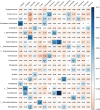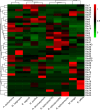The role of host traits and geography in shaping the gut microbiome of insectivorous bats
- PMID: 38509042
- PMCID: PMC11036801
- DOI: 10.1128/msphere.00087-24
The role of host traits and geography in shaping the gut microbiome of insectivorous bats
Abstract
The gut microbiome is a symbiotic microbial community associated with the host and plays multiple important roles in host physiology, nutrition, and health. A number of factors have been shown to influence the gut microbiome, among which diet is considered to be one of the most important; however, the relationship between diet composition and gut microbiota in wild mammals is still not well recognized. Herein, we characterized the gut microbiota of bats and examined the effects of diet, host taxa, body size, gender, elevation, and latitude on the gut microbiota. The cytochrome C oxidase subunit I (COI) gene and 16S rRNA gene amplicons were sequenced from the feces of eight insectivorous bat species in southern China, including Miniopterus fuliginosus, Aselliscus stoliczkanus, Myotis laniger, Rhinolophus episcopus, Rhinolophus osgoodi, Rhinolophus ferrumequinum, Rhinolophus affinis, and Rhinolophus pusillus. The results showed that the composition of gut microbiome and diet exhibited significant differences among bat species. Diet composition and gut microbiota were significantly correlated at the order, family, genus, and operational taxonomic unit levels, while certain insects had a marked effect on the gut microbiome at specific taxonomic levels. In addition, elevation, latitude, body weight of bats, and host species had significant effects on the gut microbiome, but phylosymbiosis between host phylogeny and gut microbiome was lacking. These findings clarify the relationship between gut microbiome and diet and contribute to improving our understanding of host ecology and the evolution of the gut microbiome in wild mammals.
Importance: The gut microbiome is critical for the adaptation of wildlife to the dynamic environment. Bats are the second-largest group of mammals with short intestinal tract, yet their gut microbiome is still poorly studied. Herein, we explored the relationships between gut microbiome and food composition, host taxa, body size, gender, elevation, and latitude. We found a significant association between diet composition and gut microbiome in insectivorous bats, with certain insect species having major impacts on gut microbiome. Factors like species taxa, body weight, elevation, and latitude also affected the gut microbiome, but we failed to detect phylosymbiosis between the host phylogeny and the gut microbiome. Overall, our study presents novel insights into how multiple factors shape the bat's gut microbiome together and provides a study case on host-microbe interactions in wildlife.
Keywords: 16S rRNA; diet composition; gut microbiome; high-throughput sequencing; insectivorous bats.
Conflict of interest statement
The authors declare no conflict of interest.
Figures






Similar articles
-
Investigating the gut bacteria structure and function of hibernating bats through 16S rRNA high-throughput sequencing and culturomics.mSystems. 2025 May 20;10(5):e0146324. doi: 10.1128/msystems.01463-24. Epub 2025 Apr 9. mSystems. 2025. PMID: 40202348 Free PMC article.
-
Gut microbial diversity in two insectivorous bats: Insights into the effect of different sampling sources.Microbiologyopen. 2019 Apr;8(4):e00670. doi: 10.1002/mbo3.670. Epub 2018 Jul 3. Microbiologyopen. 2019. PMID: 29971963 Free PMC article.
-
Seasonal Dietary Shifts Alter the Gut Microbiota of Avivorous Bats: Implication for Adaptation to Energy Harvest and Nutritional Utilization.mSphere. 2021 Aug 25;6(4):e0046721. doi: 10.1128/mSphere.00467-21. Epub 2021 Aug 4. mSphere. 2021. PMID: 34346703 Free PMC article.
-
Bats Are an Untapped System for Understanding Microbiome Evolution in Mammals.mSphere. 2018 Sep 19;3(5):e00397-18. doi: 10.1128/mSphere.00397-18. mSphere. 2018. PMID: 30232167 Free PMC article. Review.
-
Helminth-Induced Human Gastrointestinal Dysbiosis: a Systematic Review and Meta-Analysis Reveals Insights into Altered Taxon Diversity and Microbial Gradient Collapse.mBio. 2021 Dec 21;12(6):e0289021. doi: 10.1128/mBio.02890-21. Epub 2021 Dec 21. mBio. 2021. PMID: 34933444 Free PMC article.
Cited by
-
Comparative Analysis of Gut Microbiome Community Structures in Different Populations of Asian Elephants in China and Their Correlation with Diet.Genes (Basel). 2025 Apr 25;16(5):483. doi: 10.3390/genes16050483. Genes (Basel). 2025. PMID: 40428305 Free PMC article.
-
Polygonatum polysaccharides as gut microbiota modulators: implications for autophagy-dependent PD-L1 clearance in cancer immunotherapy.Front Nutr. 2025 Jun 24;12:1612644. doi: 10.3389/fnut.2025.1612644. eCollection 2025. Front Nutr. 2025. PMID: 40630164 Free PMC article. Review.
-
Investigating the gut bacteria structure and function of hibernating bats through 16S rRNA high-throughput sequencing and culturomics.mSystems. 2025 May 20;10(5):e0146324. doi: 10.1128/msystems.01463-24. Epub 2025 Apr 9. mSystems. 2025. PMID: 40202348 Free PMC article.
-
Metagenomic Investigation of Intestinal Microbiota of Insectivorous Synanthropic Bats: Densoviruses, Antibiotic Resistance Genes, and Functional Profiling of Gut Microbial Communities.Int J Mol Sci. 2025 Jun 20;26(13):5941. doi: 10.3390/ijms26135941. Int J Mol Sci. 2025. PMID: 40649719 Free PMC article.
-
The fecal microbiota of the mouse-eared bat (Myotis velifer) with new records of microbial taxa for bats.PLoS One. 2024 Dec 5;19(12):e0314847. doi: 10.1371/journal.pone.0314847. eCollection 2024. PLoS One. 2024. PMID: 39637086 Free PMC article.
References
-
- Amato KR. 2013. Co-evolution in context: the importance of studying gut microbiomes in wild animals. Microbiome Sci Med 1:10–29. doi:10.2478/micsm-2013-0002 - DOI
Publication types
MeSH terms
Substances
Grants and funding
- 32171525/MOST | National Natural Science Foundation of China (NSFC)
- 31961123001/MOST | National Natural Science Foundation of China (NSFC)
- 20220101291JC/| Natural Science Foundation of Jilin Province (Jilin Natural Science Foundation)
- 20230101160JC/| Natural Science Foundation of Jilin Province (Jilin Natural Science Foundation)
LinkOut - more resources
Full Text Sources
Medical
